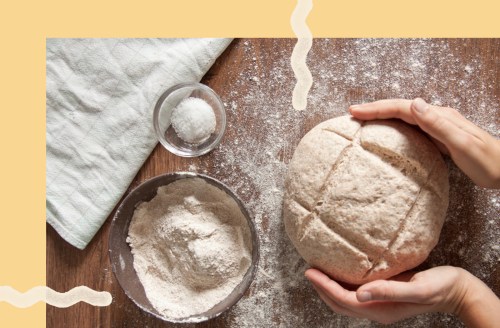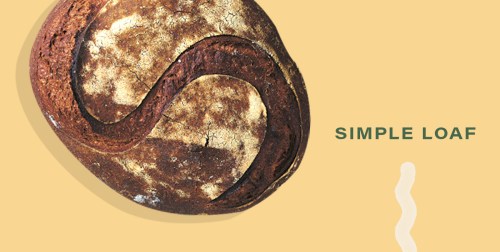Our editors independently select these products. Making a purchase through our links may earn Well+Good a commission
3 homemade bread recipes for different skill levels because baking is everyone’s new hobby
Bread making can be as easy or difficult as you'd like. Zachary Golper, chef and owner of Bien Cuit, shares his best homemade bread recipes.

Baking bread is one of those things that seems so difficult and aspirational that no mortal would ever have time to do it. But right about now, some of us are finding we have far more time on our hands than we’d like. Grab some flour and whip out your wooden spoon, because the time to unlock the magic of homemade bread recipes is now.
Zachary Golper, chef and owner of Bien Cuit, a beloved bakery with three locations in New York City, is here to help fulfill your bread-baking dreams. The James Beard Award semifinalist authored Bien Cuit: The Art of Bread, a cookbook with dozens of delightful homemade bread recipes, and he shared three of his favorite recipes with Well+Good—one each for beginner, intermediate, and advanced bakers.
To taste Golper’s bread yourself, you can order Bien Cuit loaves from anywhere in the country or order through Borough Provisions if you’re in parts of Manhattan and Brooklyn. To try your hand at making bread, browse the recipes below and make one (or all!) of these thoughtful recipes.
Homemade bread recipes for every level of baker
Beginner: A Simple Loaf

“It’s a lovely loaf,” says Golper. “It’s about as easy as it gets.” This bread is made using biga, which is an Italian word for a non-sourdough bread starter. “This biga is made with all rye flour, so that will ferment pretty quickly, as compared with wheat flour,” he says. “It’ll give you some some interesting notes after about 12 hours of fermentation.”
And though it’s a simple recipe, it’ll take a few days to complete because the yeast needs time to ferment before baking.
Ingredients
Starter:1/2 cup + 2 tbsp white rye flour1/4 cup + 2 ½ tbsp dark rye flourGenerous 1/4 tsp instant yeast1/2 cup + 1 tsp water at about 60°F
Dough:3 cup + 2 ½ tsp white flour, plus additional as needed for working with the dough1/2 cup + 1 ½ tsp whole wheat flour2 ½ tsp fine sea saltGenerous 1/4 tsp instant yeast1 ½ cup + 1 tsp water at about 60°F
Dusting mixture:1 part fine semolina flour5 parts white flour
For the starter:
1. Stir together the white and dark rye flours in a medium storage container.
2. Sprinkle the yeast into the water, stir to mix, and pour over the flour.
3. Mix with your fingers, pressing the mixture into the sides, bottom, and corners until all of the flour is wet and fully incorporated.
4. Cover the container and let sit at room temperature for 11 to 15 hours. The starter will be at its peak at around 13 hours.
For the dough:
1. Stir together the white and whole wheat flours, salt, and yeast in a medium bowl.
2. Pour about 1/3 of the water around the edges of the starter to release it from the sides of the container. Transfer the starter and water into an extra-large bowl along with the remaining water. Using a wooden spoon, break the starter up to distribute in the water.
3. Add the flour mixture, reserving about one-sixth along the edge of the bowl. Continue to mix with the spoon until most of the dry ingredients have been combined with the stater mixture. Switch to a Plastic Bowl Scraper ($8) and continue to mix until incorporated. At this point the dough will be sticky to the touch.
4. Push the dough to one side of the bowl. Roll and tuck the dough, adding the reserved flour mixture and a small amount of additional flour to the bowl and your hands as needed. To roll and tuck, make the dough into a rectangle with the short end facing you. Slide your fingers under the first 3 inches of the dough, roll it towards you, and push it down lightly with your hands, tucking the folded end into the mass of dough. Continue until the dough is rolled up. Rotate the dough so the short side is facing you, press the seam in, and create a rectangle. Repeat the process ending with the seam side down. Repeat this process until the dough feels stronger and begins to resist any further rolling, about 16 times. Then, with cupped hands, tuck the sides under toward the center. Place the dough, seam-side down, in a clean bowl, cover the top of the bowl with a lean kitchen towel, and let rest at room temperature for 45 minutes.
5. For the first stretch and fold, lightly dust the work surface and your hands with flour (not with the dusting mixture—save that for the lined proofing basket and shaped loaf). Using the plastic bowl scrapper, release the dough from the bowl and set it seam-side down, on the work surface. Gently stretch it into a roughly rectangular shape. Fold the dough in thirds from top to bottom and then from left to right. With cupped hands, tuck the sides under toward the center. Place the dough in the bowl, seam-side down, cover the bowl with the towel, and let rest for 45 minutes.
6. For the second stretch and fold, repeat the steps for the first stretch and fold, then return the dough to the bowl, cover with the towel, and let rest for 45 minutes.
7. For the third and final stretch and fold, once again repeat the steps for the first stretch and fold, then return the dough to the bowl, cover with the towel, and let it rest for 20 minutes.
8. Line a 9-inch Proofing Basket ($18) or bowl with a clean kitchen towel fairly generously with the dusting mixture.
9. Lightly dust the work surface and your hands with flour and shape the dough into a round. Dust the sides and top of the dough with the dusting mixture, fold the edges of the towel over the top, and let rest at room temperature for 1 hour.
10. Transfer the basket to the refrigerator and chill for 14 to 18 hours.
11. Position an over rack in the lower third of the oven. Place a covered 6-quart, 10-inch round Cast-Iron Dutch Oven ($70) on the rack. Preheat the oven to 500°F. Remove the basket of dough from the refrigerator and let it sit at room temperature while you allow the oven to preheat for 1 hour.
12. Using heavy-duty oven mitts or pot holders, remove the Dutch oven, place it on a heatproof surface, and remove the lid.
13. Using the kitchen towel, lift and gently ease the dough out of the basket and onto a backing peel, seam-side down. Then carefully transfer it into the pot (the Dutch oven will be very hot). Score the top of the dough, cover the pit, and return it to the oven. Lower the oven temperature to 460°F and bake for 30 minutes.
14. Rotate the Dutch oven and remove the lid. The loaf will already be a rich golden brown. Continue baking, uncovered, until the surface is a deep, rich brown, with some spots along the score being even slightly darker (bien cuit), about 20 minutes longer.
15. Loosen the edges of the loaf with a long-handled spoon and then with the help of the spoon life out of the pot onto a cooling rack. When the bottom of the loaf is tapped, it should sound hollow. If not, return it to the oven and bake directly on the rack for 5 minutes longer.
16. Let the bread cool completely before slicing and eating, at least 4 hours but preferably 8 to 24 hours.
Intermediate: Toasted Oatmeal Rolls

Golper loves these rolls, and says while they’re not wildly difficult to make, the dough is really weird, making them harder to manage. “It’s not going to feel like other doughs that you’ve worked with,” he says. “It’s very silky.”
Ingredients
Toasted Oats:1/4 cup + 3 tbsp steel-cut oats
Starter:1/4 cup + 2 tbsp oatmeal, prepared from the toasted oats3 tbsp + 2 tsp white flourSmall pinch (0.1 grams) instant yeast1/4 cup + 1 tsp water at about 60°F
Dough:2 cups white flour, plus additional as needed for working with the dough1/2 cup toasted oat flour, prepared from the toasted oats2 tbsp + 2 tsp light brown sugar1 ½ tsp fine sea salt1/4 tsp instant yeast3/4 cup + 2 tsp cold whole milk1/4 cup + 3 ½ tbsp cold heavy cream1/2 cup + 2 ½ tbsp toasted oats
Dusting mixture:1 part fine semolina flour5 parts white flour
For the toasted oats:
1. Preheat the oven to 425°F. Spread the oats on a half sheet pan and toast for 4 minutes. Gently shake the pan, then toast for 4 minutes longer. Shake again and toast until aromatic and evenly golden brown, 2 to 4 minutes longer. Let cool completely. The oats will decrease slightly in weight when toasted (explaining why the following amounts don’t quite add up to the amount prior to toasting). Set aside 1/4 cup + 1 ½ tbsp of the toasted oats to make the oatmeal for the starter. Measure out 1/2 cup to grind into flour. Set the rest of the toasted oats aside for later use. This should be about 1/2 cup + 2 ½ tbsp.
2. Put the 1/2 cup of oats to a high-powered blender or a coffee grinder and process to form a fine flour.
For the starter:
1. Combine the 1/4 cup + 1 ½ tbsp of the toasted oats and 1/2 cup + 1 tbsp of water in a small saucepan over medium high heat. Bring to a simmer, then decrease the heat to maintain a low simmer and cook, stirring often, until the oats are softened and the water has been absorbed, about 10 minutes. You will need 1/4 cup + 2 tbsp of the prepared oatmeal for the starter.
2. Stir together the 1/4 cup + 2 tbsp of prepared oatmeal and the white flour in a medium storage container. Sprinkle the yeast into the water, stir to mix, and pour over the oatmeal mixture. Mix with your fingers, pressing the mixture into the sides, bottom, and corners until all of the flour is wet and fully incorporated. Cover the container and let sit at room temperature for 10 to 15 hours. The starter will be at its peak at around 13 hours.
For the dough:
1. Stir together the white and toasted oat flours, brown sugar, salt, and yeast in a small bowl.
2. Combine the milk and heavy cream in a measuring cup. Pour about 1/3 of the mixture around the edges of the starter to release it from the sides of the container. Transfer the starter and milk mixture to an extra-large bowl along with the remaining milk mixture. Using a wooden spoon, break the starter up to distribute it in the liquid.
3. Add the flour mixture, reserving about 1/6 of it along the edge of the bowl. Continue to mix with the spoon until most of the dry ingredients have been combined with the starter mixture. Switch to a Plastic Bowl Scraper ($8) and continue to mix until incorporated. At this point the dough will be very sticky to the touch and fairly loose.
4. Push the dough to one side of the bowl. Roll and tuck the dough, adding the reserved flour mixture and a small amount of additional flour to the bowl and your hands as needed. For this dough you may need more flour, but resist the urge to add it too quickly. If the dough seems too sticky, let it rest for 5 minutes, then come back to it. To roll and tuck, make the dough into a rectangle with the short end facing you. Slide your fingers under the first 3 inches of the dough, roll it towards you, and push it down lightly with your hands, tucking the folded end into the mass of dough. Continue until the dough is rolled up. Rotate the dough so the short side is facing you, press the seam in, and create a rectangle. Repeat the process ending with the seam side down. Repeat this process until the dough feels stronger and begins to resist any further rolling, about 10 times. Then, with cupped hands, tuck the sides under toward the center. Place the dough, seam-side down, in a clean bowl, cover the top of the bowl with a clean kitchen towel, and let rest at room temperature for 45 minutes.
5. For the first stretch and fold, lightly dust the work surface and your hands with flour (not the dusting mixture—save that for the linen liner and shaped rolls). Using the plastic bowl scraper, release the dough from the bowl and set it, seam-side down, on the work surface. Gently stretch it into a roughly rectangular shape. Fold the dough in thirds from top to bottom and then from left to right. With cupped hands, tuck the sides under toward the center. Place the dough in the bowl, seam-side down, cover the bowl with the towel, and let rest for 45 minutes.
6. For the second stretch and fold, repeat the steps for the first stretch and fold, then return the dough to the bowl, cover with the towel, and let rest for 45 minutes.
7. For the third and final stretch and fold, gently stretch the dough into a rectangle, scatter the toasted oats on top, and gently press them into the dough. Roll up the dough tightly from the end closest to you; at the end of the roll the dough will be seam-side down. Turn it over, seam-side up, and gently press on the seam to flatten the dough slightly. Fold in thirds from left to right and then do one roll and tuck sequence to incorporate the oats. Turn the dough seam-side down and tuck the sides under toward the center. Return the dough to the bowl, cover with the towel, and let rest for 20 minutes.
8. Line a half sheet pan with a Linen Liner ($13) and dust fairly generously with the dusting mixture.
9. Lightly dust the work surface and your hands with flour. Using a Bench Scraper ($10), divide the dough into 12 equal pieces (about 75g each). Gently roll each piece against the work surface to form a ball. Let rest for 5 minutes.
10. Using a bowl scraper and working with one ball at a time, cut the ball almost in half, stopping just before the bottom and leaving about 1/8 inch (3mm) uncut; keep the halves attached. Make a second cut across the first, stopping at the same point, just before the bottom. There will now be an X across the round. Next, using your thumb and forefinger, press two opposite sections toward the center to square off the sides. Repeat with the remaining two sides to make a square roll. Arrange the rolls, cut-side down, on the lined pan in three rows of four rolls each and dust well with the dusting mixture. Fold the linen to create support walls along the rolls on both sides of each row. Fold any extra length of the linen liner over the top or cover with a kitchen towel. Transfer the pan to the refrigerator and chill for about 16 to 22 hours.
11. Set up the oven with a Cast-Iron Skillet ($23) for steam, then pre-heat the oven to 500°F. Line a half sheet pan with a Silicone Baking Mat ($8) or parchment paper.
12. Using the linen liner, lift and ease each roll off the pan and onto your hand. Set the rolls on the second pan, cut-side up, in three rows of four rolls each.
13. Put the pan in the oven. Using heavy-duty oven mitts or potholders, pull out the hot skillet, add about 1 ½ cups of ice cubes, then slide it back in and close the oven door. Immediately lower the oven temperature to 465°F and bake, rotating the pan about two-thirds of the way through baking, until the tops of the rolls are golden brown, 15 to 20 minutes.
14. Set the sheet pan on a cooling rack. Give the rolls a few minutes to cool slightly, then place them directly on the cooling rack and let cool completely, about 1 hour. The rolls are best eaten the day they’re baked, but once completely cooled they can be stored (uncut) in a paper bag or cardboard box for up to 24 hours.
Advanced: Ciabatta

Though this seems like a relatively simple bread, Golper says it’s incredibly difficult to make without a professional machine. And he means a professional machines stronger than your Kitchen Aid Stand Alone Mixer—though a top-of-the-line small appliance, he says the machine has to work really hard when working with bread dough, which can ultimately shorten its life span.
This dough recipe is stared with a poolish, which is basically a super wet biga. “This dough is so so so so wet that it’s very hard to work with,” he says. “In the very beginning stages in the folding process—that’s going to be like folding soup.”
Ingredients
Starter:1 ¾ cup + 1 tbsp white flourPinch (0.2 g) instant yeast1 cup + 2 tsp water at about 60°F
Dough:3 ½ cup + 1 tbsp white flour, plus additional as needed for working with the dough1 tbsp + ¼ tsp fine sea salt1/2 tsp instant yeast1 ¾ cup + 2 tbsp water at about 60°F1 tbsp + 1 tsp honey2 Tbsp extra-virgin olive oil
Dusting mixture:1 part fine semolina flour5 parts white flour
For the starter:
1. Put the flour in a medium storage container. Sprinkle the yeast into the water, stir to mix, and pour over the flour. Mix with your fingers, pressing the mixture into the sides, bottom, and corners until all of the flour is wet and fully incorporated. Cover the container and let sit at room temperature for 10 to 15 hours. The starter will be at its peak at around 12 hours.
For the dough:
1. Spray two large storage containers, each about 2 quarts and preferably round, generously with nonstick cooking spray, or oil them generously with a neutral oil.
2. Stir together the flour, salt, and yeast in a medium bowl.
3. Pour about one-third of the water around the edges of the starter to release it from the sides of the container. Transfer the starter and water to an extra-large bowl along with the remaining water, the honey, and the oil. Using a wooden spoon, break the starter up to distribute it in the liquid. Add the flour mixture and stir vigorously with a wooden spoon for 1 minute.
4. Pour the dough, which will have a texture a little thicker than pancake batter, into one of the sprayed containers. Cover the container and let the dough rest for 45 minutes.
5. For the first stretch and fold, generously dust the work surface, the plastic bowl scraper, and your hands with flour (not the dusting mixture—save this for the sheet pans). Using the scraper, release the batter-like dough from the bowl and onto the work surface. Lightly dust the second storage container with flour.
6. With the scraper (and your hands, if needed), do your best to fold the dough in thirds from top to bottom and then from left to right. This fold may be difficult with the batter still being soupy, but it should have enough stretch that it’s manageable. With the scraper, tuck the sides under toward the center and then lift the dough, placing it seam-side down in the second prepared container. Cover the container and let the dough rest for 45 minutes.
7. For the second stretch and fold, repeat the steps for the first stretch and fold, then return the dough to the container, cover, and let rest for 45 minutes.
8. For the third stretch and fold, once again repeat the steps for the first stretch and fold, then return the dough to the container, cover and let rest for 45 minutes.
9. For the fourth and final stretch and fold, repeat the steps for the first stretch and fold, then return the dough to the container, cover, and let rest for 30 minutes.
10. Transfer the container to the refrigerator and chill for 12 to 18 hours.
11. Using a plastic bowl scraper, turn the dough out onto a generously floured work surface (for these loaves, preferably a butcher block or large wooden board). The dough will spread on its own. Divide the dough into two equal pieces and gently coax each piece into a rough rectangle. Cover the loaves, preferably with a plastic tub or a clean cardboard box; if neither is available, spray plastic wrap with nonstick cooking spray or oil it and lay it over the loaves (at the end of the final fermentation, be sure to remove the plastic carefully so as to not deflate the dough).
12. Let the dough rest until the loaves have increased substantially in volume (about doubled in size), about 3 hours. (The amount of time can vary significantly depending on the temperature of the room.) Dust one finger with flour and press it into the dough. The imprint should remain. If it doesn’t, leave the dough to ferment until it does. If fermenting under a tub, check from time to time to make sure the top of the dough is soft. If at any point a skin begins to form, give it a light spritz of water with a spray bottle.
13. Set up the oven with a Cast-Iron Skillet ($23) for steam, then preheat the oven to 480°F.
14. Line two half sheet pans with parchment paper and dust with the dusting mixture. Position the first lined pan close to one piece of the dough. Uncover that piece of dough, leaving the second piece covered.
15. The next steps are done as a series of consecutive events. Gently flip the first piece of dough over onto your hands. Bring your thumbs and fingers together and gently stretch the width of the dough from top to bottom to make a rectangle about 1 ½ inches (4 cm) thick; the exact size doesn’t matter as much as the thickness. Place it on a sheet pan. Be sure to keep the second piece of dough covered while the first one bakes.
16. Put the pan in the oven. Using heavy-duty oven mitts or potholders, pull out the hot skillet, add about 3 cups of ice cubes, then slide it back in and close the oven door. Immediately lower the oven temperature to 440°F and bake the first loaf, rotating the pan about two-thirds of the way through baking, until golden brown, about 20 minutes.
17. Carefully transfer the loaf to a cooling rack. When the bottom of the loaf is tapped, it should sound hollow. If not, return it to the oven and bake directly on the rack for 5 minutes longer.
18. Carefully remove the skillet and pour out any remaining water. Set the skillet back on the lower rack and let the oven temperature return to 480°F (250°C). Bake the second loaf in the same way, again using about 3 cups of ice to create steam.
19. Let the bread cool completely before slicing and eating, at least 2 hours. This bread is best eaten the day it is baked.
Once you finish making bread, try this recipe for vegan, gluten-free chocolate chip cookies, or this recipe for healthy blueberry pie.









